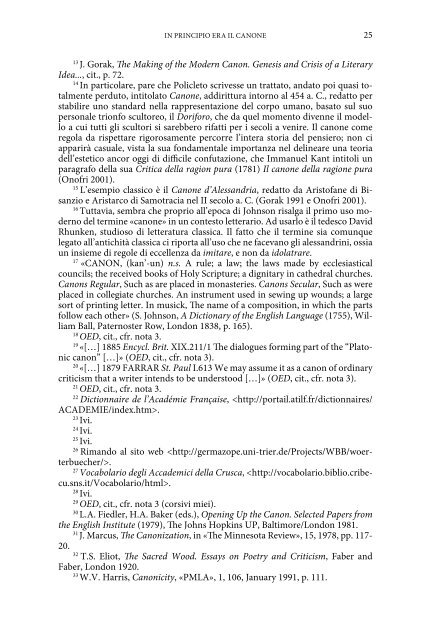biblioteca di studi di filologia moderna – 10 - Firenze University Press
biblioteca di studi di filologia moderna – 10 - Firenze University Press
biblioteca di studi di filologia moderna – 10 - Firenze University Press
You also want an ePaper? Increase the reach of your titles
YUMPU automatically turns print PDFs into web optimized ePapers that Google loves.
in PrinciPio era il canone 25<br />
13 J. gorak, The Making of the Modern Canon. Genesis and Crisis of a Literary<br />
Idea..., cit., p. 72.<br />
14 in particolare, pare che Policleto scrivesse un trattato, andato poi quasi totalmente<br />
perduto, intitolato Canone, ad<strong>di</strong>rittura intorno al 454 a. c., redatto per<br />
stabilire uno standard nella rappresentazione del corpo umano, basato sul suo<br />
personale trionfo scultoreo, il Doriforo, che da quel momento <strong>di</strong>venne il modello<br />
a cui tutti gli scultori si sarebbero rifatti per i secoli a venire. il canone come<br />
regola da rispettare rigorosamente percorre l’intera storia del pensiero; non ci<br />
apparirà casuale, vista la sua fondamentale importanza nel delineare una teoria<br />
dell’estetico ancor oggi <strong>di</strong> <strong>di</strong>fficile confutazione, che immanuel Kant intitoli un<br />
paragrafo della sua Critica della ragion pura (1781) Il canone della ragione pura<br />
(onofri 2001).<br />
15 l’esempio classico è il Canone d’Alessandria, redatto da aristofane <strong>di</strong> bisanzio<br />
e aristarco <strong>di</strong> samotracia nel ii secolo a. c. (gorak 1991 e onofri 2001).<br />
16 tuttavia, sembra che proprio all’epoca <strong>di</strong> Johnson risalga il primo uso moderno<br />
del termine «canone» in un contesto letterario. ad usarlo è il tedesco david<br />
rhunken, stu<strong>di</strong>oso <strong>di</strong> letteratura classica. il fatto che il termine sia comunque<br />
legato all’antichità classica ci riporta all’uso che ne facevano gli alessandrini, ossia<br />
un insieme <strong>di</strong> regole <strong>di</strong> eccellenza da imitare, e non da idolatrare.<br />
17 «canon, (kan’-un) n.s. a rule; a law; the laws made by ecclesiastical<br />
councils; the received books of Holy scripture; a <strong>di</strong>gnitary in cathedral churches.<br />
Canons Regular, such as are placed in monasteries. Canons Secular, such as were<br />
placed in collegiate churches. an instrument used in sewing up wounds; a large<br />
sort of printing letter. in musick, The name of a composition, in which the parts<br />
follow each other» (s. Johnson, A Dictionary of the English Language (1755), William<br />
ball, Paternoster row, london 1838, p. 165).<br />
18 OED, cit., cfr. nota 3.<br />
19 «[…] 1885 Encycl. Brit. XiX.211/1 The <strong>di</strong>alogues forming part of the “Platonic<br />
canon” […]» (OED, cit., cfr. nota 3).<br />
20 «[…] 1879 farrar St. Paul i.613 We may assume it as a canon of or<strong>di</strong>nary<br />
criticism that a writer intends to be understood […]» (OED, cit., cfr. nota 3).<br />
21 OED, cit., cfr. nota 3.<br />
22 Dictionnaire de l’Académie Française, .<br />
23 ivi.<br />
24 ivi.<br />
25 ivi.<br />
26 rimando al sito web .<br />
27 Vocabolario degli Accademici della Crusca, .<br />
28 ivi.<br />
29 OED, cit., cfr. nota 3 (corsivi miei).<br />
30 l.a. fiedler, H.a. baker (eds.), Opening Up the Canon. Selected Papers from<br />
the English Institute (1979), The Johns Hopkins uP, baltimore/london 1981.<br />
31 J. marcus, The Canonization, in «The minnesota review», 15, 1978, pp. 117-<br />
20.<br />
32 t.s. eliot, The Sacred Wood. Essays on Poetry and Criticism, faber and<br />
faber, london 1920.<br />
33 W.V. Harris, Canonicity, «Pmla», 1, <strong>10</strong>6, January 1991, p. 111.
















